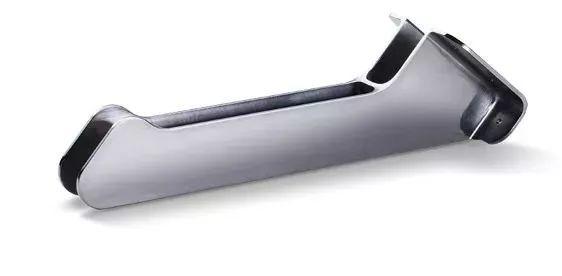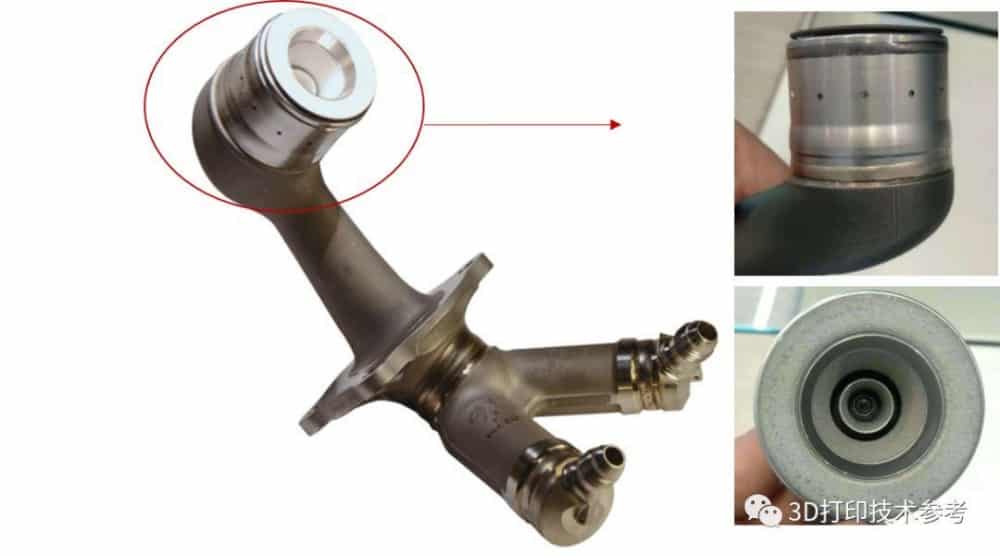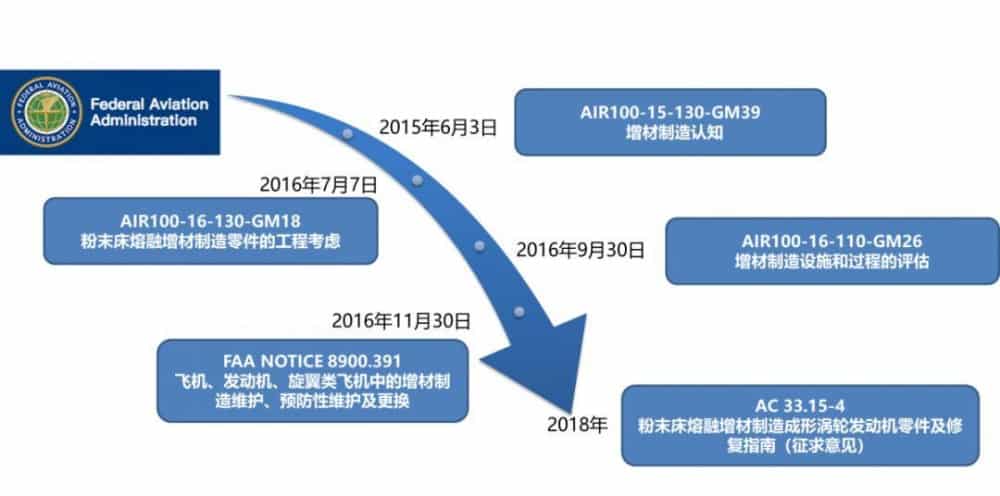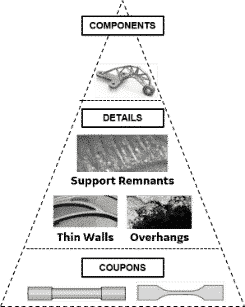With the continuous deepening of research on additive manufacturing technology at home and abroad, the application potential of additive manufacturing products in the field of aviation has gradually become more prominent. Boeing of the United States used DED technology to produce structural components for its 787 Dreamliner, and used Norsk Titanium’s Rapid Plasma Deposition ™ technology for the research and development of aircraft structural parts. Through technical research and improvement and a series of rigorous tests, it was finally completed in February 2017. Obtained the first FAA certification of 3D printed titanium alloy structural parts.
Rapid Plasma Deposition ™ Technology 3D Prints Titanium Alloy Structural Parts
GE has used additive manufacturing fuel nozzles in its LEAP engine. The fuel nozzle uses Hastelloy X high-temperature alloy as an additive manufacturing material. It is currently the first additive manufacturing aviation engine component in the world that has passed airworthiness certification.
Additive manufacturing of LEAP engine fuel nozzles
With the application advantages and potential of additive manufacturing in the aviation field, how to conduct airworthiness review and certification of additive manufacturing, an emerging manufacturing technology, has attracted the attention of the FAA, and has carried out the following work (see figure below).
The starting point of airworthiness certification starts with the knowledge of technology
On June 3, 2015, FAA released the Memorandum of AIR 100-15-130-GM39 “Awareness of Additive Manufacturing”, proposing that the National Team for Additive Manufacturing (AMNT) be formed by the Design, Manufacturing and Airworthiness Department (AIR-100) ), Collect information about AM applications and serve as a technical resource for ongoing AM certification research. This information will help AMNT identify technical issues and develop guidelines to promote AM parts to obtain FAA certification.
Questions (considerations) are the basis of airworthiness review and certification
On July 7, 2016, FAA released the Memorandum AIR100-16-130-GM18 “Engineering Considerations for Powder Bed Melt Additive Manufacturing Parts”. The memo does not provide guidance for AM component certification, but from product design, raw materials, and forming Questions (considerations) were raised in the process, post-processing, testing methods, process verification, material design value acquisition, and other aspects (including technical documents, electronic documents, process control, forming interruption, heterogeneous pollutant control, traceability, etc.). These engineering questions (consideration) are to provide a good starting point for the certification discussion with the applicant, and be recorded in the required problem file (IP), laying the foundation for subsequent airworthiness review and certification.
On-site audit and update iteration is the guarantee to determine the requirements of the evaluation review
On September 30, 2016, the FAA issued a memorandum on AIR 100-16-110-GM26 “Assessment of Additive Manufacturing Facilities and Processes”, which aims to help aviation safety inspectors (ASI) to evaluate AM facilities and processes and assist in review The personnel collect key process parameters, and conduct full process review from personnel training, site facilities, technical data, raw material handling, equipment, software control, manufacturing process effectiveness, manufacturing process monitoring, testing, metallurgical processes, etc., and accumulate data, Update iterations and conduct new certification activities. With the maturity of additive manufacturing processes and processes and the improvement of industry standardization, the AMNT is expected to revise this document frequently.
Provide guidance for maintenance process certification based on needs
On November 30, 2016, the FAA released NOTICE 8900.391 “Additive Manufacturing Maintenance, Preventive Maintenance, and Replacement of Aircraft, Engines, and Propellers”, mainly for the participation of aircraft standard services (AFS) personnel in aircraft, engines and rotorcraft Provide certification and supervision guidance during maintenance, preventive maintenance and replacement of the system. At the same time, FAA management, operations and administrative personnel can also refer to this document for related work. The implementation period of the document is set at 1 year and will be abolished on November 30, 2017.
AC further guides airworthiness compliance verification
In 2018, the FAA released the consultation draft of AC 33.15-4 “Guidelines for the Repair and Forming of Parts for Formed Turbine Engines by Powder Bed Melting Additives”. The FAA ’s Advisory Circular (AC) is a method of airworthiness compliance verification (not mandatory) given by the FAA to all aircraft model applicants. It is used to indicate compliance with airworthiness clauses or topics. FAA directly recognizes, in principle, CAAC / EASA is also recognized. Although this document is not the final document issued by the FAA, it still has important reference value and significance for how to ensure the quality of additive manufacturing (here only the powder bed fusion (PBF) method). The provisions of AC 33.15-4 will be briefly described below.
AC 33.15-4 gives an acceptable method for demonstrating compliance with the Federal Regulation 14 CFR §33.15 for the maintenance of parts and product parts of shaped turbine engines by powder bed fusion (PBF) additive manufacturing (AM) And provided guidance on AM related design and manufacturing. Due to the strong process dependence of PBF AM forming, the design value of its materials is not only related to the variability of raw materials purchased by manufacturers, but also to the variability introduced by the manufacturing process used to manufacture production parts and maintenance. It is necessary to fully understand the parameter variables of the entire process in order to achieve the level of control required for stable and repeatable production of parts. Therefore, AC 33.15-4 provides guidance on 6 aspects of material design values, design, materials and forming, post-processing, testing, process verification, etc.
The test procedure should be standardized, and the allowable value of material design should be obtained
In terms of material design values, AC 33.15-4 proposes to establish a standardized test procedure, using the basic criteria of typical and representative test samples (considering forming batch, forming position, sample orientation, raw material batch, etc.); Consider the effective process window, the actual situation of the product (anisotropy, porosity, poor fusion, etc.), the qualification of the testing laboratory, etc. to guarantee the test of the sample; adopt the building block verification method similar to the composite material (see below) Figure), to ensure product development through multi-level building block verification at the sample level, detail level, component level, etc .; in the allowable value of the finished material design, the characterization of the anisotropy of the additive manufacturing material and the minimum material design limit must be considered The establishment of the value, the compensation of the functional margin of the parts, etc., finally establish the allowable value of the material design.
Building block verification
Process characteristics and constraints, design considerations need to be comprehensive
For additive manufacturing, a strong design-related manufacturing technology, from airworthiness considerations should start from the part design. AC 33.15-4 provides guidance in terms of part design, part orientation, dimensional control, surface condition, support structure, powder removal, etc. When designing parts, anisotropy, unique defects of additive manufacturing and the best detection timing and method of defects should be fully considered; when forming parts according to the characteristics of material anisotropy, residual stress generation, self-supporting and overhanging curved surfaces Orientation; consider the forming ability of the process and equipment, the residual stress arising from the elimination, post-heat treatment and thermal isothermal pressing and other thermal cycles to control the size of the product; consider the surface finish requirements of the parts, internal surface treatment, surface The effect of state on mechanical properties and reliability and the coating of protective coatings on parts and products; consider the reduction in the number of support structures during part production and the effect of support structures on heat transfer and shape retention; consider powder removal and formulate corresponding procedures and specifications To verify the effect of potential residual powder on the expected function of the part.
The production process must be stable, and technical specifications are indispensable
In terms of materials and manufacturing, it mainly provides certification guidance from the research and development of materials and processes and the control of materials and processes. In the material and process development stage, fully consider the source of variability and take appropriate control measures to reduce material performance changes; through raw material specifications, melting process specifications, heat treatment specifications, personnel qualification and certification, equipment qualification, maintenance and calibration, and other methods, Qualified metallurgical process identification, after approval, can consistently produce parts that meet the design requirements; in terms of materials and process control, consideration should be given to establishing standardized documents for raw material specifications, raw material reuse requirements, process specifications, parts material specifications, etc. For airworthiness certification.
Post-processing specifications need to be clear, and potential impact should be stated
In the post-forming process, the post-forming process and procedures must be standardized and explained, including the removal of residual powder, definition, and solution of residual stress, method and sequence of taking parts, method and sequence of support removal, heat treatment and hot isostatic pressing Process parameters and microstructure requirements, technical specifications for protective coatings and their potential impact on material properties.
The detection method needs to be clear, and the test requirements should be given
PBF AM is a layer-by-layer deposition process, which may produce defects that do not have a significant height in the forming direction (for example, planar defects formed along the forming surface and having only 1-2 layers of poor fusion, etc.). In addition, the morphological surface is rough, which may mask surface defects and be difficult to detect. All conventional non-destructive testing (for example, X-ray, fluorescence, ultrasound, eddy current) is suitable for AM parts inspection but may require new or combined methods to detect defects generated by the AM process. Therefore, when testing AM parts, it is necessary to clarify the inherent defects and defect threshold standards of the parts materials, determine the inspection timing, select the appropriate detection methods and standards, ensure that the surface state meets NDI inspection requirements, and deal with complex geometries and internal features through CT and other methods. Of detection. AC 33.15-4 pointed out that CT is currently the only inspection method approved to inspect internal features that are not directly accessible, but its cost, time, and capabilities need to be considered.
The process needs to be verified, and changes must be based
In order to ensure the stable and reproducible production of parts that meet the design requirements of size, performance, and quality, AC 33.15-4 proposes to carry out process verification, including process verification methods, process type identification, equipment identification, multiple equipment identifications, and key process changes Related requirements. When the technological process and parameters change, reliable test data, and basis must be provided for explanation.
The formulation and future release of AC 33.15-4 by the FAA shows that the application of additive manufacturing in the aviation field has initially entered the stage of practical engineering application and mass production, and its prescribed requirements reflect all aspects and processes from product design and development to batch production. Systematic and standardized technical documents are needed to ensure the quality consistency and reproducibility of product production. This has important guidance for improving the quality of domestic additive manufacturing products and promoting the application of additive manufacturing in various industries. Reference value.




